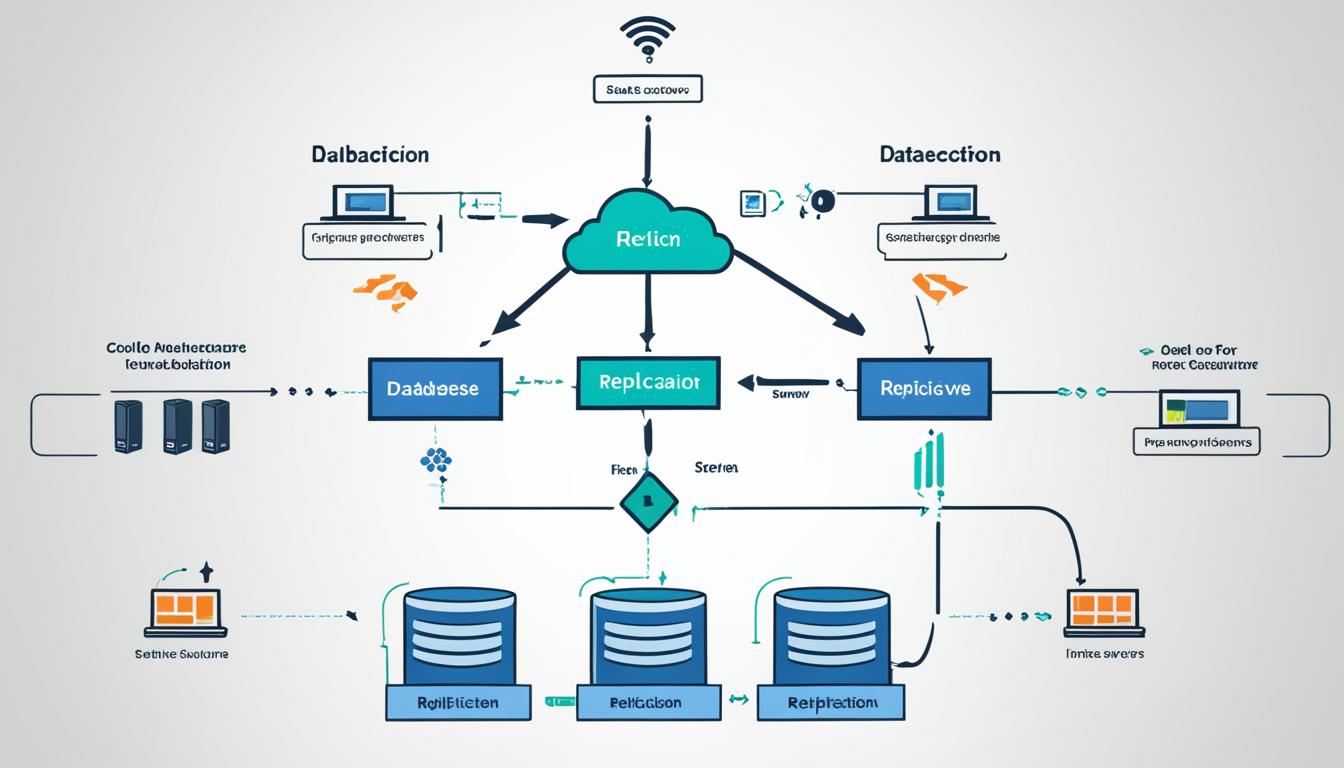What is Database Replication Explained
Database replication plays a crucial role in ensuring data availability and accessibility in organizations. It involves electronically copying data from one database to another, creating a distributed database where all users can access the same level of information. This process allows for quick and seamless data retrieval without interfering with others’ work.
Database replication comes in different types, including asynchronous and synchronous replication, each with its own benefits and considerations. Additionally, organizations can choose from various architectural models such as single-leader, multi-leader, and no-leader replication.
Implementing database replication offers several advantages. It helps reduce server load and improves efficiency by distributing data processing across multiple servers. Database replication also enhances data availability, making it easier for users to access up-to-date and reliable information. Moreover, it contributes to load reduction, as multiple copies of the database are available, ensuring high availability.
However, database replication does come with challenges. Data loss and inconsistency can occur if not implemented properly, requiring organizations to carefully consider replication techniques and invest in the right tools or software.
Key Takeaways:
- Database replication is the process of electronically copying data from one database to another.
- It ensures that all users have access to the same level of information and improves data availability and accessibility.
- Types of database replication include asynchronous and synchronous replication, with different architectural models available.
- Database replication offers benefits such as load reduction, improved efficiency, and high availability.
- Implementing database replication requires considering replication techniques and investing in the right tools or software.
How Database Replication Works
Database replication is a fundamental process in managing data across distributed infrastructures. It ensures that changes made to data at one location are automatically reflected in the data stored at other locations. This section will dive into the intricacies of how database replication works, including the different replication processes and techniques.
To facilitate database replication, organizations use a distributed database management system (DBMS) that coordinates the replication process. This system manages data sources across various locations, ensuring that all replicas stay synchronized in real-time.
There are two primary types of database replication: active/active replication and read-only replication.
Active/Active Replication
In active/active replication, every system can process changes, and the databases are bidirectionally synchronized. This means that clients can read from and write to any replica, and the changes will be propagated to all other replicas. Active/active replication provides high availability and load balancing, as the workload is distributed across multiple databases.
Read-Only Replication
On the other hand, read-only replication involves replicating databases that can only receive changes from the primary database. In this type of replication, the primary database handles write operations, while the replicated databases are only used for reading purposes. Read-only replication is commonly used for reporting or analytical purposes, as it enhances performance by offloading read tasks from the primary database.
Database replication can be a one-time occurrence or a continuous process. Continuous database replication ensures that the data is always up to date, allowing users to access the most recent information at any given time.
Here is an overview of the database replication process:
- Changes are made to the data at a specific location.
- The distributed DBMS detects these changes.
- The changes are propagated to all other replicas in the system.
- The distributed DBMS ensures that the replicas stay synchronized by handling conflicts and resolving any inconsistencies.
Database replication offers numerous benefits, including improved data availability, disaster recovery, and reduced latency. In the next sections, we will explore these benefits in more detail to understand why organizations choose to implement database replication.
https://www.youtube.com/watch?v=s77kf1jzGJ0
Benefits of Database Replication
Database replication offers several benefits to organizations. Let’s take a closer look at how it can improve disaster recovery, lower data latency, and reduce server load.
Improved Disaster Recovery
One of the key benefits of database replication is improved disaster recovery. By creating multiple copies of the database and distributing them across different locations, organizations can reduce the risk of data loss in the event of a disaster. If one database becomes unavailable, the replicated copies can still be accessed, ensuring continuity of operations and minimizing downtime.
Lower Data Latency
Database replication also helps lower data latency, which refers to the delay in accessing and retrieving data. By replicating the database across multiple servers, organizations can bring data closer to the users, reducing the time it takes to retrieve information. This localized data access improves user experience and enhances the overall efficiency of data-driven processes.
Reduced Server Load
Another significant benefit of database replication is the reduction of server load. By distributing data processing across multiple servers, the workload is balanced, resulting in improved performance and faster response times. This not only enhances the user experience but also allows organizations to handle larger volumes of data without overwhelming a single server.
Replicating databases offers benefits beyond the ones mentioned above. It can increase data availability and accessibility, making it easier for users to access up-to-date and reliable information. Organizations can leverage database replication to optimize their disaster recovery strategies, improve overall system performance, and enhance data integrity.
Types of Database Replication
When it comes to database replication, organizations have several options to choose from based on their specific requirements. Let’s explore the various types of database replication:
1. Full-Table Replication
Full-table replication involves copying everything from the source database to the destination, including new, existing, and updated data. This replication technique ensures that both databases are identical in terms of their content. It is suitable when maintaining a complete replica of the source database is necessary.
2. Snapshot Replication
Snapshot replication captures a specific moment in time by taking a snapshot of the source database and replicating that data to the destination. Unlike other replication techniques, snapshot replication doesn’t capture subsequent changes made to the source database. It is useful when a consistent snapshot of data is required across multiple databases.
3. Merge Replication
Merge replication allows for the combination of two or more databases into a single database. Each independent database can make changes that are then merged into a central database. This replication technique is suitable for scenarios where decentralized changes need to be consolidated.
4. Key-Based Incremental Replication
Key-based incremental replication focuses on replicating only the relevant changes based on a specified replication key, such as a timestamp or integer. This replication technique ensures that changes are efficiently transmitted and applied to the destination database, reducing replication overhead and optimizing performance.
5. Log-Based Incremental Replication
Log-based incremental replication tracks changes made to the source database by analyzing its binary log files. This technique copies the changes recorded in the database’s transaction log and applies them to the destination database. Log-based replication is commonly used in scenarios where near-real-time data synchronization is required.
6. Transactional Replication
Transactional replication is a comprehensive replication method that copies all existing data from the source database to the destination and then continuously replicates any new changes. This type of replication ensures data consistency and integrity throughout the replication process, making it a reliable choice for many organizations.

In summary, organizations can choose from various types of database replication to meet their specific needs. Whether it’s full-table replication for complete data synchronization or log-based incremental replication for near-real-time updates, each technique offers distinct advantages. Understanding these different types of database replication is essential for making informed decisions when implementing database replication strategies.
Conclusion
Database replication is a critical component in ensuring the availability and accessibility of data within organizations. By distributing data across multiple databases, the risk of data loss is minimized, while data reliability is increased. The selection of replication techniques and types is dependent on the organization’s unique needs and infrastructure. Implementing effective database replication involves careful consideration of replication techniques, selection of appropriate tools or software, and a dedicated focus on maintaining data consistency.
Understanding the process and benefits of database replication empowers organizations to make informed decisions that enhance their data management and accessibility. With the right replication strategies in place, organizations can mitigate the risk of data loss, improve disaster recovery capabilities, reduce server load, and lower data latency. Database replication provides a foundation for robust and efficient data management in today’s dynamic business environment.
In conclusion, database replication is a key factor for organizations seeking to secure and optimize their data management processes. By leveraging the advantages offered by replication techniques, organizations can achieve higher data availability, minimized data loss risks, and improved performance across their infrastructure. As technology continues to advance, organizations must stay informed about the latest database replication solutions and best practices in order to effectively manage and leverage their data resources.
FAQ
What is database replication?
Database replication is the process of electronically copying data from one database to another, ensuring that all users have access to the same level of information.
What are the benefits of database replication?
Database replication offers benefits such as improved disaster recovery, lower data latency, reduced server load, and increased data availability and accessibility.
What are the types of database replication?
The types of database replication include full-table replication, snapshot replication, merge replication, key-based incremental replication, log-based incremental replication, and transactional replication.
How does database replication work?
Database replication works by copying changes made to the data at one location to all other locations, ensuring that the databases are synchronized. It can be done in a continuous manner or based on specific snapshots.
What are the best practices for implementing database replication?
Best practices for implementing database replication include choosing the appropriate replication technique based on organizational needs, investing in reliable replication tools or software, and ensuring data consistency.
- About the Author
- Latest Posts
Janina is a technical editor at Text-Center.com and loves to write about computer technology and latest trends in information technology. She also works for Biteno.com.






